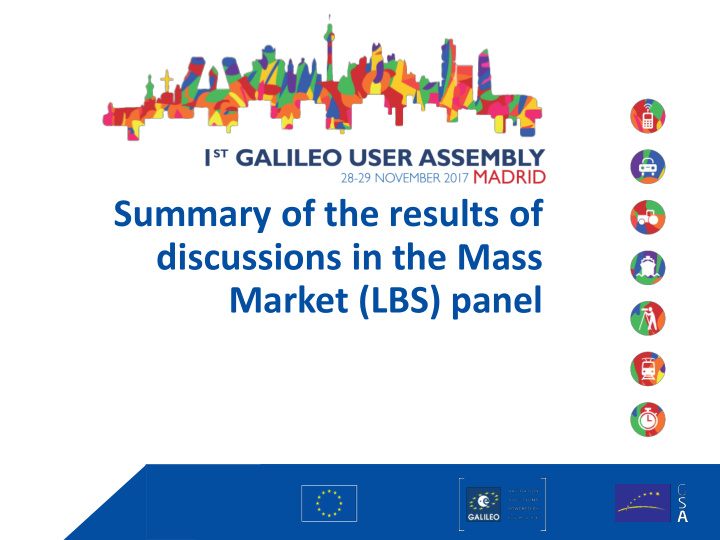



Summary of the results of discussions in the Mass Market (LBS) panel
Agenda • Our recommendations for the User Requirements Document • Our perceived R&D needs • Recommendations for enhancing EGNSS Services and GSC user support • Answers to other strategic questions 2
Highlights of our recommendations for the User Requirements document • Performance parameters were reviewed and values by application updated substantially – challenging task with contradicting opinions! • Main drivers of user requirements: ‒ Use of location is increasing ‒ Using smartphones for more professional applications ‒ Crowdsourcing ‒ More privacy concerns • Main user requirements expected to change: ‒ Accuracy (horizontal) – more accuracy needed ‒ Susceptibility to difficult environmental conditions ‒ Power consumption reduction – “always on” ‒ Integrity needed for an increasing number of apps ‒ Authentication beyond OS NMA ‒ Availability – towards full ubiquity 3
Our identified R&D needs • Most promising areas in mass market for R&D funding: ‒ LBS seamless indoor outdoor navigation ‒ UAVs for mass market ‒ Logistics (as part of IoT) ‒ Development of augmentation infrastructure for higher accuracy • Top challenges to be solved via the R&D: ‒ Commercial competitiveness of EU ‒ Bridging gaps between communities (GNSS and IT) ‒ Standardization ‒ Technical limitations: Antennas, Resilience (anty-spoofing), Power consumption 4
Our identified R&D needs • Main technology trends to be addressed in future R&D calls: ‒ Hybridisation ‒ Multi-frequency ‒ Ubiquity ‒ Transparency of use for augmentation services • EGNSS service(s) that are the more relevant for R&D in mass market: ‒ Galileo OS, CS • Optimal size for R&D projects sponsored by EU Institutions: ‒ More than 1 M € • There is a need to increase the number of projects funded (double) 5
Recommendations for enhancing EGNSS Services and GSC user support • Galileo System Performance: signals are reliable, measurement quality as expected, satellites orbits and clocks are predictable supporting Predicted Orbit solutions, 2 nd frequency appreciated and entering mass market. Faster acquisition is needed. OSNMA is first step for authentication that should be expanded. GGTO should be improved in terms of availability and accuracy. It would be useful to have standardized way of providing orbital data for all constellations (e.g via IGS). • Opportunity to provide feedback through industry consultation appreciated (e.g. OS NMA) • High quality SIS ICD, Technology and Market report highly appreciated • GSC: well organized web site, comprehensive source of information, timely updates. • Commercial Service: support for Galileo E6 signals may increase device cost. Check possibility to deliver CS on E5 or E1 (e.g via GEO). Free Commercial Service interesting and could go beyond simple PPP. • Open APIs and libraries for app developers to prototype on commercial and open HW. 6
A last set of questions… • Which technologies can fulfil the requirements of your sector today? ‒ Outdoors? ‒ GNSS (of course) plus dead reckoning and IMUs, cellular positioning, SLAM, computer vision, barometer, RFID ‒ Indoors? Same plus wifi, Bluetooth, UWB • Out of these technologies, which is the primary PNT solution at the moment, what are the alternative technologies you are using as backup if any? ‒ Outdoors? Main is GNSS, rest back up and support ‒ Indoors? Main is Wifi, rest back up and support • What is your perception for the evolution of your requirements and related primary and alternative PNT systems for the future? ‒ Discussed in previous slides 7
With the contributions of: In mass market we had a wide range of participants from chipset manufacturers, device manufacturers, application developers, OS providers and final users 8
Thank you! Slide 9
Recommend
More recommend